Looking for PURPLE SUCCULENTS can be CHALLENGING. It may feel OVERWHELMING and confusing as you figure out what kind of plants will best fit your NEEDS.
You want to make sure they’ll thrive in the environment that you create for them. But if you HAVEN’T had much experience with succulents before, how do you know which ones are going to WORK? But worry not. That’s where WE come in.
We are GARDENING PROFESSIONALS with years of EXPERIENCE. We’ve grown types of cacti and succulents. And yes, that includes PURPLE SUCCULENTS.
We UNDERSTAND which varieties can withstand different climates, soil, and light conditions. You get a PICTURE of what purple succulent fits YOUR NEEDS and survive in YOUR GARDEN.
So, trust us to guide you in your quest to find the IDEAL indoor or outdoor succulent planting for you.
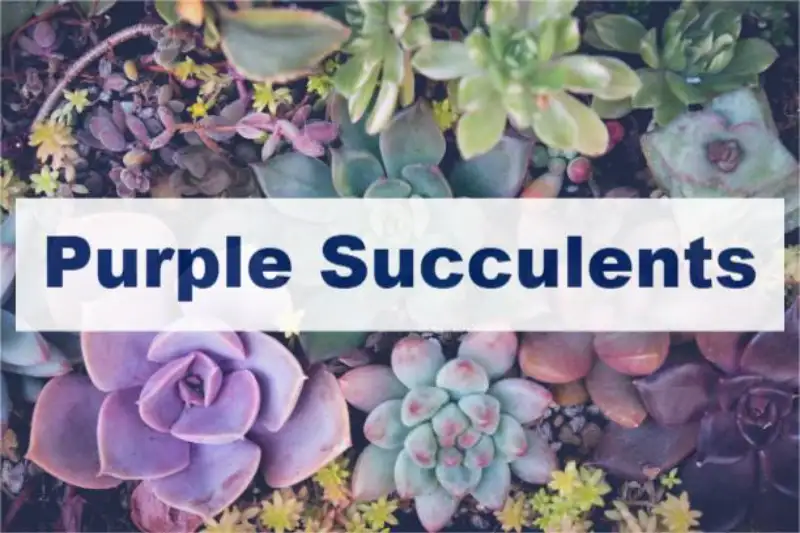
Why Choose to Plant Succulents in Your Garden?

Do you need some CONVINCING? Here is WHY you should consider getting purple succulents:
1. Easy to care for
Succulents are EASY TO CARE for and do well in warmer and indoor climates. DON’T worry if roses DRY up when you LOOK at them.
2. Variety
They come in a VAST ARRAY of colors, shapes, and sizes. So you pick the RIGHT one for your garden just like an ARTIST mixing paint on their PALLET.
3. Affordable
Purchasing and maintenance COSTS OF SUCCULENTS are VERY REASONABLE compared to other plants. They drive a hard bargain. That makes them attractive if you are on a BUDGET!
4. Mix well with others
You plant your succulents together with OTHER POPULAR VARIETIES. Think agave or aloe vera. This adds beauty to any garden space. You’ll be actually PROMOTING DIVERSITY, except with plants!
5. Grow indoors or out
Whether you have a SMALL BALCONY garden or a LARGE OUTDOOR space, succulents grow with ease. They’ll grow literally ANYWHERE! DON’T grow them in SHOES, though, no matter how much Tik Tok tries to convince you.
25 Purple Succulents
Let’s get 25 unbeatable purple options together.
1. Graptopetalum ‘Superbum’
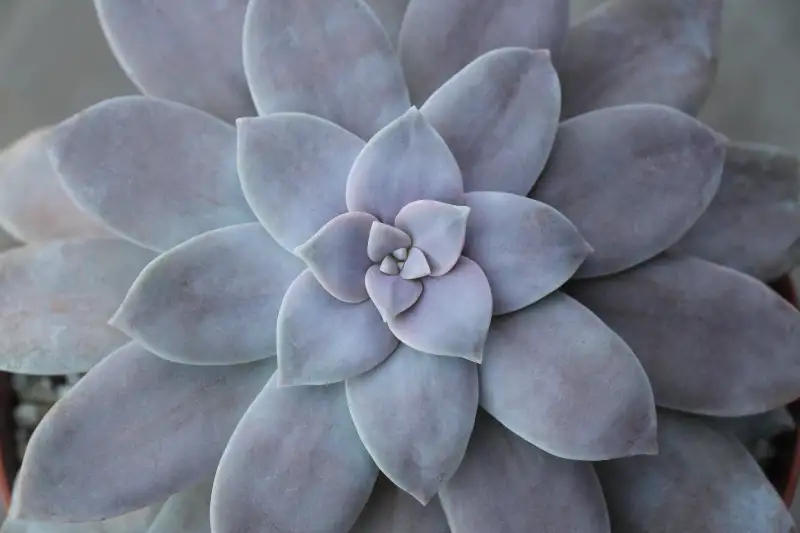
Graptopetalum ‘Superbum’ is a STUNNING PURPLE succulent. It is characterized by having short plants with deep purple hues.
And their THICK FLESHY LEAVES take on a deep purple color and are edged in an even deeper shade of the SAME COLOR. They call it ‘Superbum’ for a reason. You know, because they are thick. Hahaha.
Its star-shaped PALE YELLOW FLOWERS bear red markings at their tips, adding to the beauty.
Given enough sunlight, it blooms all season round. That makes it ideal for my indoor or outdoor decorations. It never bums me out.
Hardiness Zones: USDA zones 9 to 11.
Family: Crassulaceae
Light Requirement: Full Sun to partial shade.
Mature Size: 1 to 5 in. tall ( 10 to 12 cm) and 3 ft in spread (90 cm).
Native Area: Parts of Mexico and Arizona.
2. Anacampseros rufescens

Anacampseros rufescens are purple succulents that feature DEEP PURPLE LEAVES. This FLESHY FOLIAGE is in the shape of spoons and has BRIGHT PINK EDGES. I don’t remember SPOON SHAPES being fashionable, but this baby pulls it off!
This beauty thrives best when placed in bright light. And it produces BRIGHT PINK FLOWERS if given enough sunlight.
Anacampseros is considered HARDY, meaning it won’t give up on you easily. That’s unlike my parents. [*Remembers to see my therapist*]
Hardiness Zones: USDA zones 9 to 11.
Family: Anacampserotaceae
Light Requirement: Full Sun to partial shade.
Mature Size: 4 to 6 in. tall ( 10 to 15 cm) and 24 in. in spread (61 cm).
Native Area: Parts of South Africa
3. Echeveria ‘Afterglow’
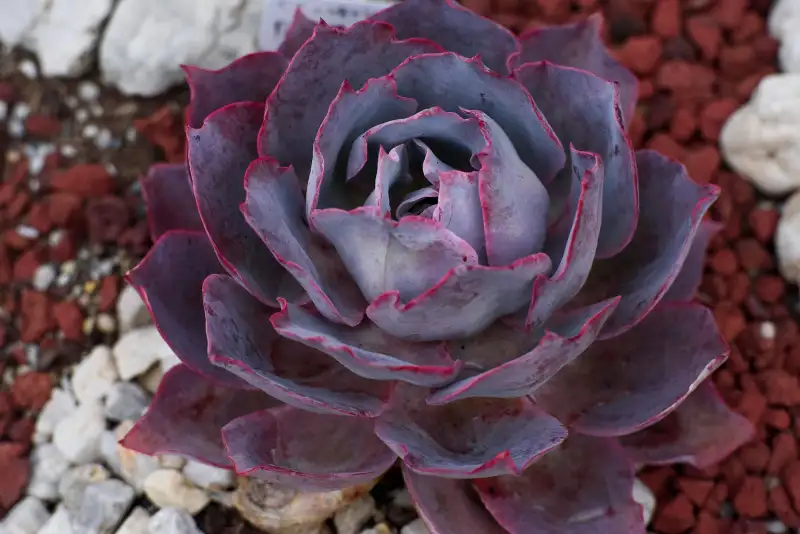
Echeveria ‘Afterglow’ is a deep purple succulent. It has FLESHY LEAVES and an attractive ROSETTE SHAPE. The purple leaves have a DELICATE RUFFLE to the edges.
This is the succulent I imagine Prince would use in his SUCCULENT GARDEN because of how purple it is.
It produces PRETTY PINK FLOWERS that sit atop the GORGEOUSLY HUED PLANT. And it looks beautiful when grown in bright sunlight.
Many gardeners choose to REMOVE the FLOWER SPIKES to encourage further growth.
Also, consider planting it in WELL-DRAINING SOIL for best results. Nobody likes soaked bottoms except Spongebob, maybe.
Hardiness Zones: USDA zones 9 to 11.
Family: Crassulaceae
Light Requirement: Full Sun to partial shade.
Mature Size: 1 to 2 in. tall (2.5 to 5 cm) and 16 in. in spread (40 cm).
Native Area: Parts of Mexico
4. Sempervivum ‘Raspberry Ice’
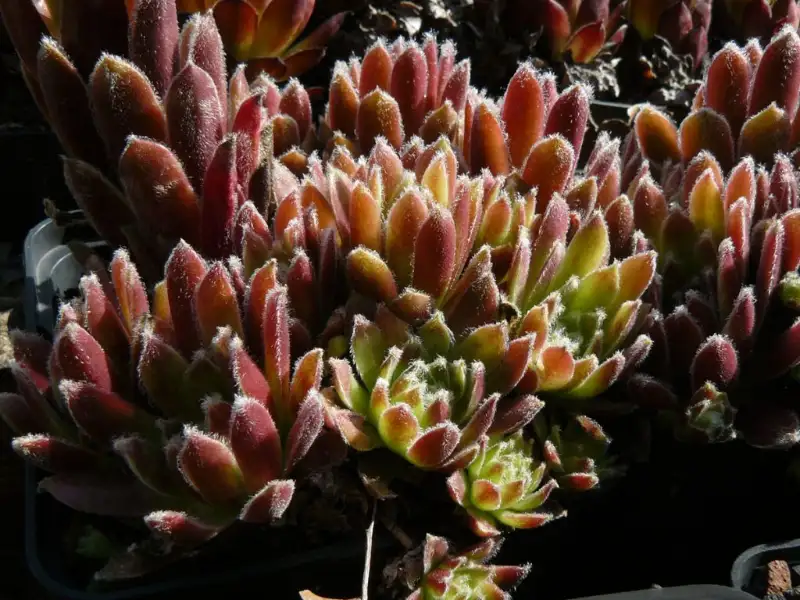
Sempervivum ‘Raspberry Ice’ is a stunning purple succulent. It has DENSELY PACKED LEAVES in a SPIRAL ROSETTE PATTERN. As they age, the leaves gradually transition from RED to their signature DEEP PURPLE HUE. It’s like planting a 90s mood ring minus the clunky tech.
With MINIMAL sunlight and water requirements, this purple succulent can thrive ALMOST ANYWHERE. It doesn’t need an IV drip or bedside care to grow. That makes it great for indoor or outdoor gardening projects.
Hardiness Zones: USDA zones 3 to 9.
Family: Crassulaceae
Light Requirement: Full Sun to partial shade.
Mature Size: 1 to 2 in. tall (2.5 to 5 cm) and 6 in. in spread (15 cm).
Native Area: Parts of Europe
5. Echeveria ‘Purple Pearl’
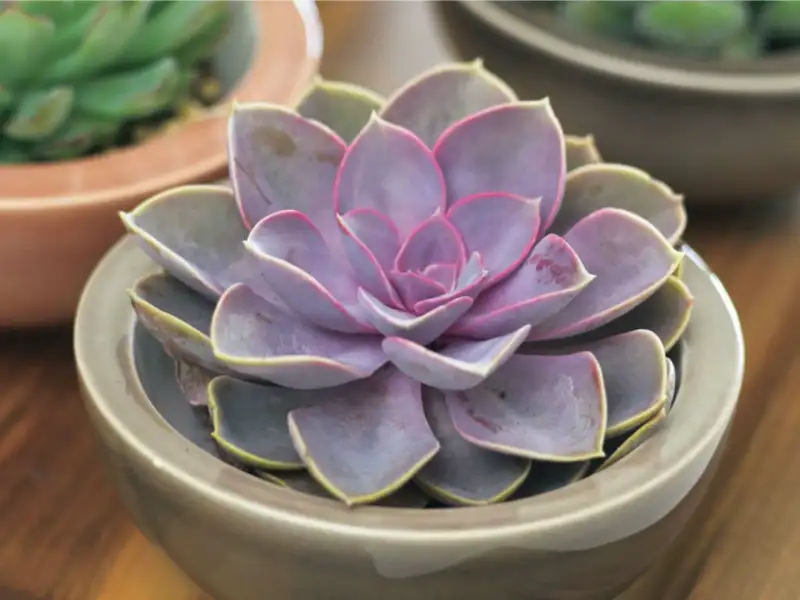
Echeveria ‘Purple Pearl’ is a GORGEOUS PURPLE SUCCULENT. It has intricately arranged LIGHT PURPLE-HUED Leaves that make Picasso’s paintings blush.
But don’t let its good looks fool you – this succulent requires less attention than your ex!
It enjoys both BRIGHT indoor light and partial sunlight. And it does well with WELL-DRAINING SOIL and INFREQUENT WATERING. I just keep it dry during the WINTER.
This bright plant is ideal for an INDOOR SETTING, giving any room an extra touch of purple beauty! And it will give you some company for those long Netflix binges.
Hardiness Zones: USDA zones 9 to 11.
Family: Crassulaceae
Light Requirement: Full Sun to partial shade.
Mature Size: 3 to 6 in. tall (7.6 to 15 cm) and 12 in. in spread (30.4 cm).
Native Area: Parts of Mexico
6. Sedeveria ‘Lilac Mist’
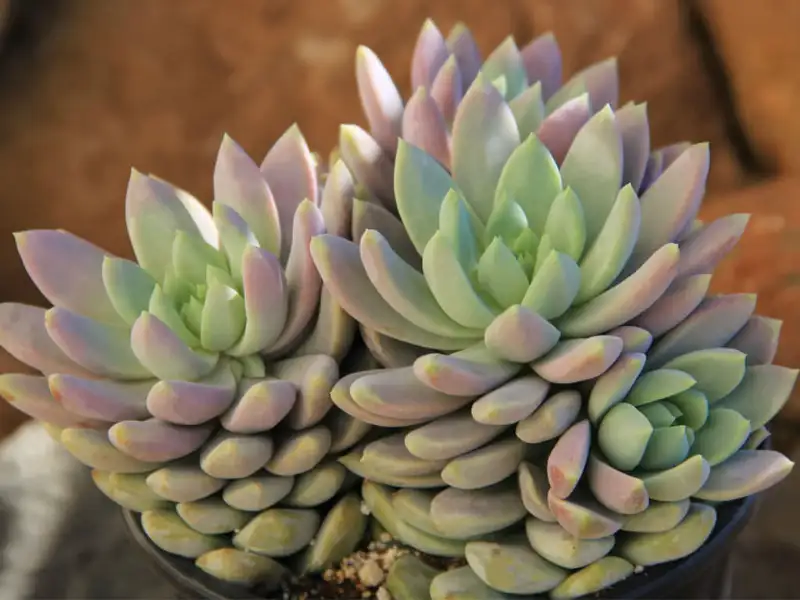
Sedeveria ‘Lilac Mist’ are stunning purple succulents. If Barney the dinosaur was a plant, he’d probably be this ‘Lilac Mist.’ It has grayish-green leaves that have a splash of lilac blush.
Plus, it has PLUMP, full leaves that can add color and TEXTURE to any area. That makes this gorgeous succulent perfect for HANGING BASKETS.
‘Lilac Mist’thrives best when the soil is WELL DRAINED and love plenty of SUNSHINE. But don’t worry if you don’t have a beach house to keep it happy. Let’s face it; tan lines aren’t really our thing anyways!
If I give it enough water during DRY SEASONS, this tough baby usually has NO PROBLEM!
Hardiness Zones: USDA zones 9 to 11.
Family: Crassulaceae
Light Requirement: Full Sun to partial shade.
Mature Size: 4 to 6 in. tall (10 to 15 cm) and 3.5 in. in spread (8.9 cm).
Native Area: Parts of America
7. Graptopetalum ‘Purple haze’
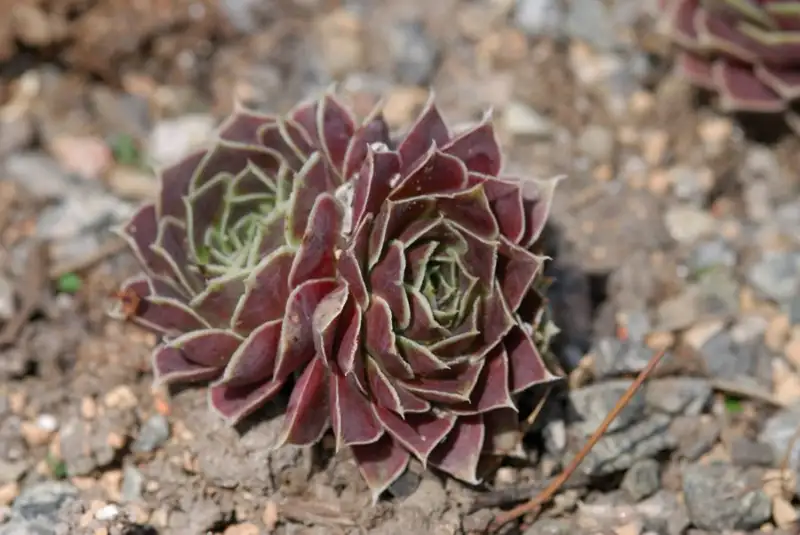
Graptopetalum ‘Purple Haze’ is a beautiful purple succulent. It has leaves of PURPLE TONES, varying from cool LAVENDERS to WARM RASPBERRY SHADES. You’d easily be fooled to think it is GRAPE JELLY.
It is a succulent that forms CLUMPS with SPREADING STEMS. In winter, their foliage is OPAQUE grey with RASPBERRY BLOBS. That’s more personality than a DRAG QUEEN on RuPaul’s Drag Race – and let’s be honest – way MORE PURPLE too!
Popular uses include as CONTAINER PLANTS and GROUND COVERS. Purple Haze is LOW MAINTENANCE. All they require is well-draining soil in sunny or partial shade areas.
Hardiness Zones: USDA zones 9 to 11.
Family: Crassulaceae
Light Requirement: Full Sun to partial shade.
Mature Size: 6 to 12 in. tall (15 to 30 cm) and 5 in. in spread (12.7 cm).
Native Area: Parts of Mexico and Arizona
8. Graptoveria Debbie
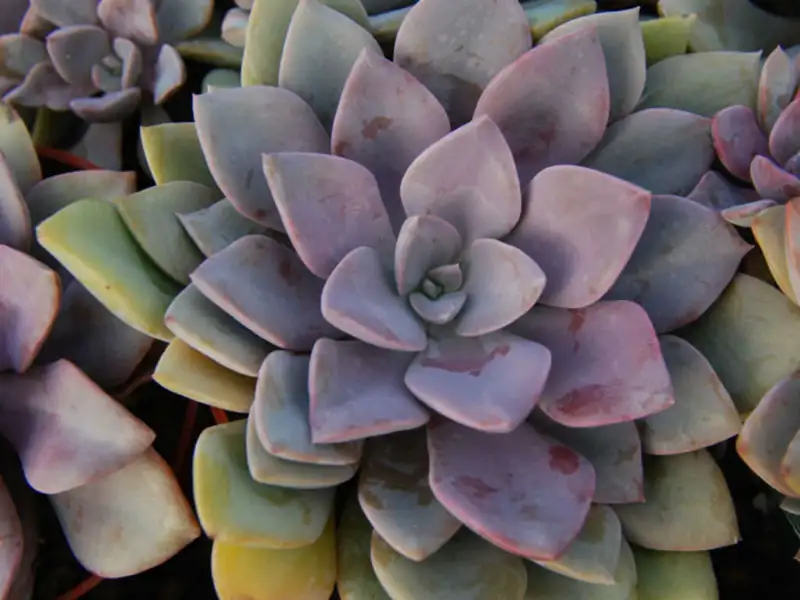
Graptoveria Debbie is a beautiful purple succulent that features a uniquely DRAMATIC FOLIAGE.
These cultivars form in a TIGHT CLUMP of ROSETTE. The clumps consist of fleshy, lanceolate, frosty pink-purple leaves. It’s like having several small bouquets in one pot!
Do you want to keep your Graptoveria healthy and vibrant? I give it BRIGHT LIGHT for at least six hours while keeping the SOIL MODERATELY MOIST.
With proper CARE and ATTENTION, these stunning purple succulents can thrive for YEARS… unlike most relationships nowadays.
Hardiness Zones: USDA zones 9 to 11.
Family: Rubiaceae
Light Requirement: Full Sun to partial shade.
Mature Size: 6 to 8 in. tall (15 to 20 cm) and 7.8 in. in spread (20 cm).
Native Area: Parts of South Africa
9. Sempervivum ‘Purple beauty’
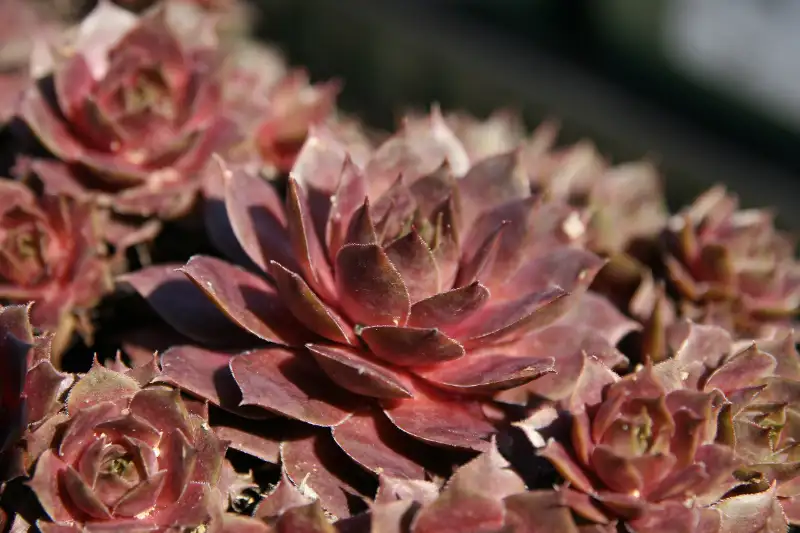
Sempervivum ‘Purple Beauty’ are gorgeous purple succulents. These plants feature FLESHY LEAVES that display an amazing DEEP PURPLE SHADE.
This small plant has BLUE-GREEN LEAVES and PURPLE CENTERS. They are so purple that they would even give Willy Wonka’s suits a run for their money.
My purple beauty bloom in EARLY SUMMER with star-shaped flowers atop long foliage. That’s just like that SUMMER BOD we all want, but few actually PULL IT OFF.
Hardiness Zones: USDA zones 3 to 8.
Family: Crassulaceae
Light Requirement: Full Sun to partial shade.
Mature Size: 3 to 4 in. tall (7.6 to 10 cm) and 8 in. in spread (20 cm).
Native Area: Parts of America
10. Echeveria ‘Black Prince’
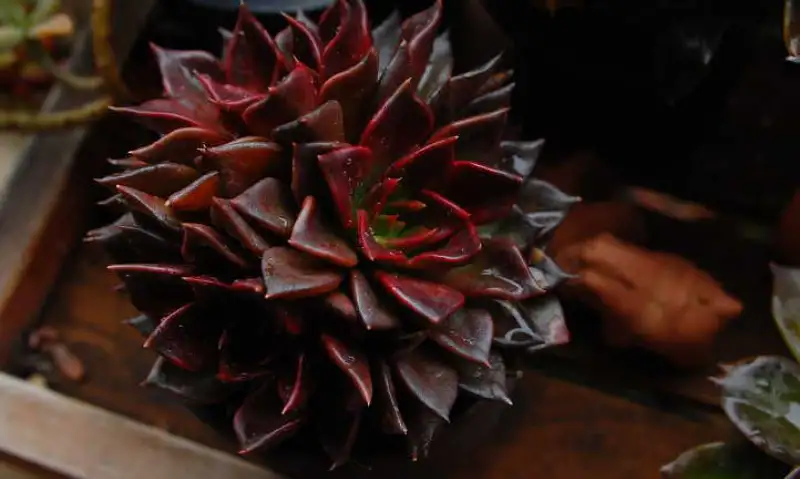
Echeveria ‘Black Prince’ is a type of purple succulent with PURPLE to DARK BROWN or BLACK LEAVES. It is so DARK and BROODING it should be cast in the next Christopher Nolan BATMAN MOVIE.
It produces a flower spike in FALL, and the blooming plants boast striking red flowers. Talk about avoiding PEAKING EARLY.
Pruning is ONLY necessary IF you want TO SHAPE it into specific forms. But be careful not to take off more tissue than needed. Otherwise, you might end up with a VIGILANTE in your garden.
Hardiness Zones: USDA zones 9 to 12.
Family: Crassulaceae
Light Requirement: Full Sun to partial shade.
Mature Size: 4 to 10 in. tall (10 to 25 cm) and 10 in. in spread (25 cm).
Native Area: Parts of Mexico
11. Sempervivum Heuffelii ‘Bora’
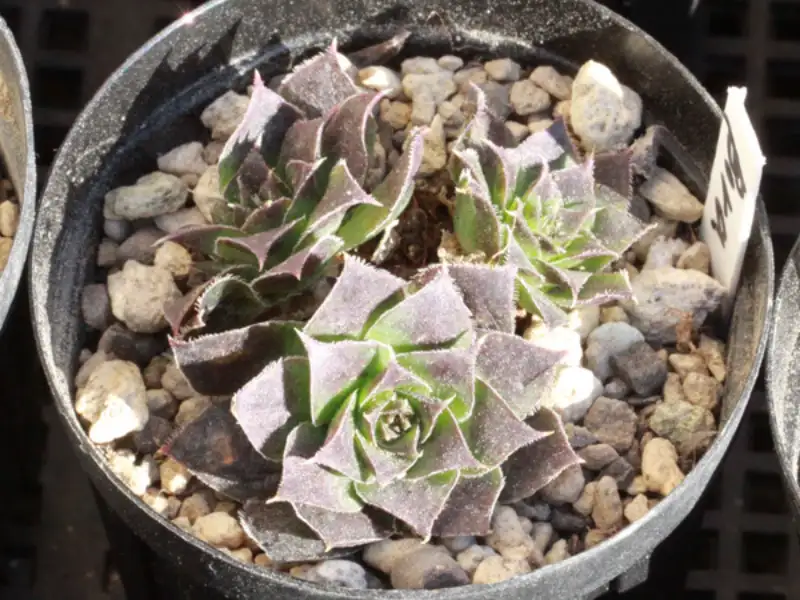
Sempervivum Heuffelii ‘Bora’ sounds like a fancy ITALIAN DISH. But it is a unique purple succulent plant.
It has purple leaves that start out with a BRIGHT GREEN heart early in the year. By winter they change color to almost BLACKISH-PURPLE. Now that’s STYLE for days. Some plants, cough cough me, rock the same colors year-round.
These succulent plants require MODERATE WATERING. Luckily, growing these plants ISN’T that hard. They can be PROPAGATED through OFFSETS or SEEDLINGS for the best growth results.
Hardiness Zones: USDA zones 4a to 9.
Family: Crassulaceae
Light Requirement: Full Sun to partial shade.
Mature Size: 1 to 3 in. tall (2.5 to 7.6 cm) and 5 in. in spread (15 cm).
Native Area: Parts of Romania to Balkan Peninsula
12. Echeveria Taurus
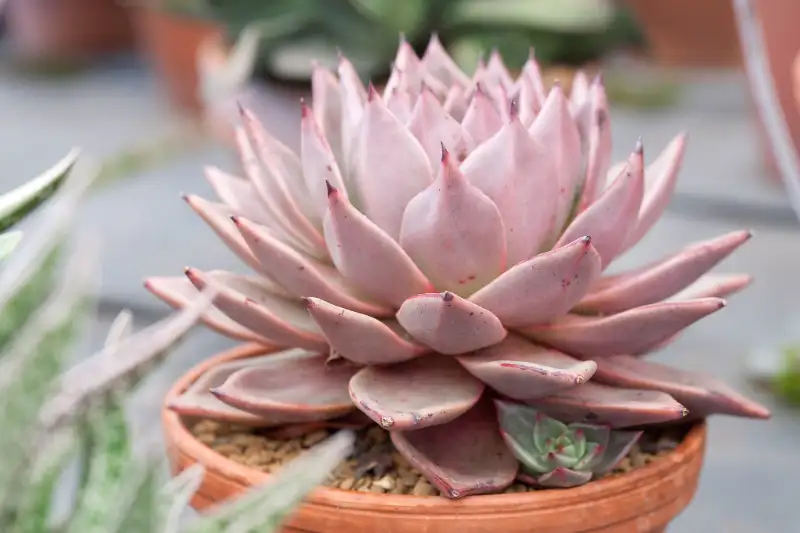
If you’re looking for a plant that’s built like a TANK and has the looks to match, then Echeveria Taurus is your guy. This beauty has large and BULKY TRIANGULAR LEAVES of reddish-purple to BLUE-GREEN COLOR.
This purple succulent gym bro produces LIGHT PINK FLOWERS in the summer. And they only need WELL-DRAINING soil with pH 6-7. AVOID overwatering, especially in WINTER for optimal growth.
Hardiness Zones: USDA zones 9 to 12.
Family: Crassulaceae
Light Requirement: Full Sun.
Mature Size: 1 to 12 in. tall (2.5 to 30 cm) and 19 in. in spread (50 cm).
Native Area: Parts of Mexico
13. Echeveria ‘Neon Breakers’
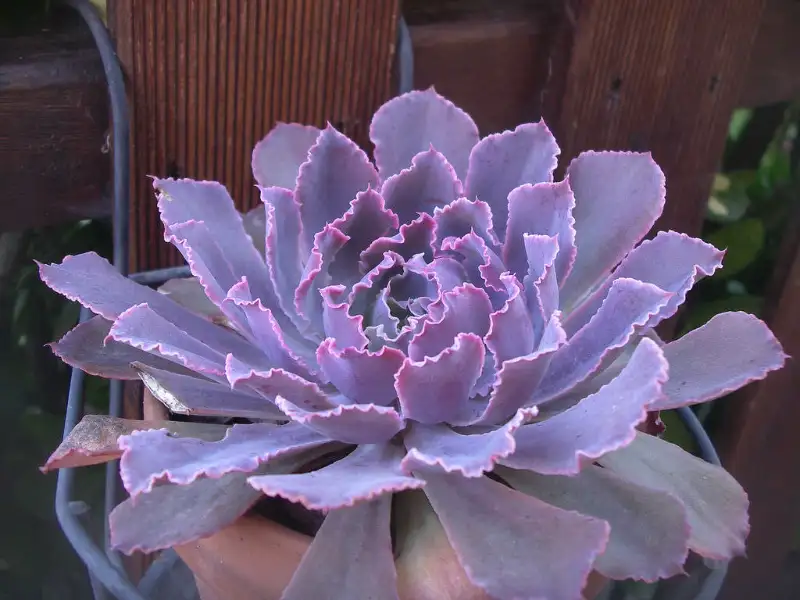
Echeveria ‘Neon Breakers’ is a beautiful perennial succulent. It features FLUORESCENT CRINKLED LEAVES adorned in purple, magenta, and orange colors. That’s more color than staring at a UNICORN on ACID. Please don’t ask me how I know.
This Bifröst also blooms with REDDISH-PURPLE FLOWERS during WARMER SEASONS. Now that’s more vibrant than my ex’s Instagram.
All I need to keep this neon glitter FULL OF COLOR is WELL-DRAINING SOIL with a pH of around 6. Moderate to MINIMAL WATERING is often ENOUGH as they are DROUGHT-TOLERANT.
Hardiness Zones: USDA zones 11 to 12.
Family: Crassulaceae
Light Requirement: Full to partial sun.
Mature Size: 1 to 5 in. tall (2.5 to 12.7 cm) and 8 in. in spread (20 cm).
Native Area: Parts of Central and Northern South America.
14. Moonstones (Pachyphytum oviferum)

Moonstones or Pachyphytum oviferums are stunning purple succulents. They like that CHILL SURFER DUDE who always chases waves down in Mexico.
They feature PINK, FAT PEBBLE-LIKE FOLIAGE covered in a thin layer of white powder. Being from Mexico, that’s SUSPICIOUS, if you know what I mean. [**Rubs my nose**]
It blooms with small white to pale pink flowers during EARLY SPRING. And this PERENNIAL SUCCULENT requires well-draining soil pH 6-7 for optimal growth.
You can propagate this beautiful plant through OFFSETS or STEM CUTTINGS. It’s almost as simple as stealing candy from a baby (but please don’t do that).
Hardiness Zones: USDA zones 9 to 10.
Family: Crassulaceae
Light Requirement: Full to partial sun.
Mature Size: 1 to 4 in. tall (2.5 to 10 cm) and 12 in. in spread (30 cm).
Native Area: Parts of Mexico.
15. Echeveria ‘Cubic Frost’
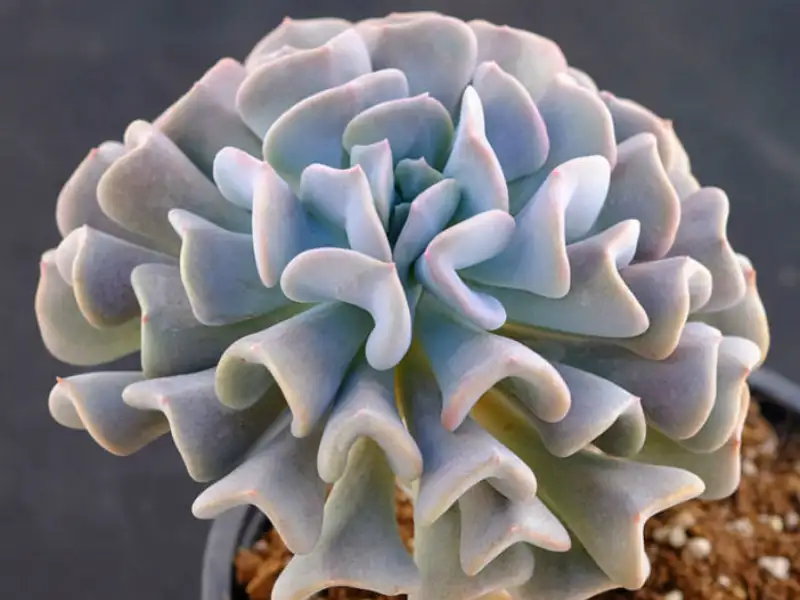
Do you want purple succulents cooler than your FAVORITE WHISKEY on the rocks? Echeveria ‘Cubic Frost’ is what you are looking for! This baby is quite a HEAD-TURNER due to its WAVY LEAVES.
Plus, its BELL-SHAPED FLOWERS bloom in summer. These bright ORANGE FLOWERS make these stunning succulents trendy additions to any garden.
This PERENNIAL SUCCULENT is an excellent choice for ground cover. Just give them well-draining soil with a soil pH of 6-7. And they’ll take over your garden FASTER than a viral TikTok trend!
Hardiness Zones: USDA zones 10 to 11.
Family: Crassulaceae
Light Requirement: Full sun to partial shade.
Mature Size: 6 to 8 in. tall (15 to 20 cm) and 10 in. in spread (25 cm).
Native Area: Parts of Southwestern Africa
16. Crassula atropurpurea ‘Purple Crassula’
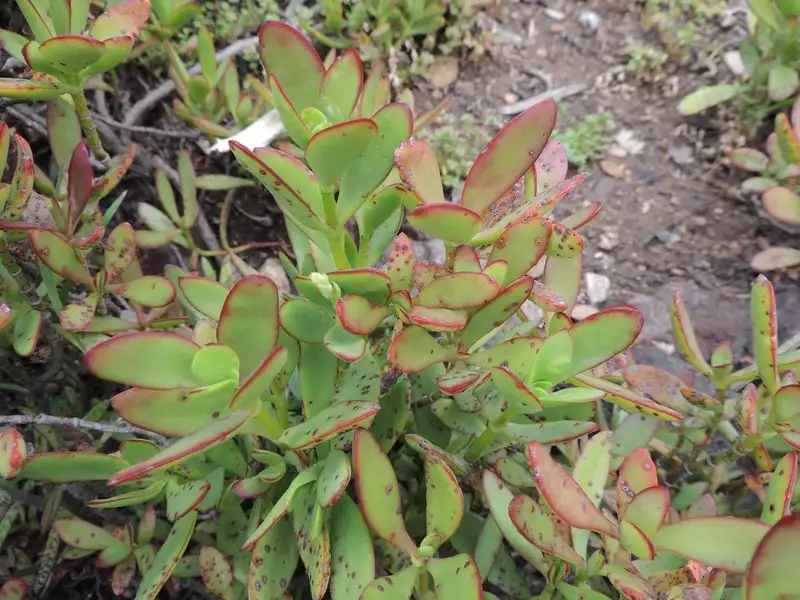
Crassula atropurpurea, ‘Purple Crassula,’ is a common succulent. It is like that QUIET but POPULAR KID in school who just knows how to make everything look EFFORTLESS.
This small succulent shows off fleshy purple WAXY LEAVES, primarily in SUMMER. Oh, you thought that’s it? BAM! The flowers are CREAMY-YELLOW and appear in early SPRING.
These make Purple Crassula a gorgeous feature in any INDOOR or OUTDOOR GARDEN. Grow it in well-draining soil with neutral pH.
Hardiness Zones: USDA zones 10 to 11.
Family: Crassulaceae
Light Requirement: Full sun to partial shade.
Mature Size: 6 to 24 in. tall (15 to 60 cm) and 12 in. in spread (30 cm).
Native Area: Parts of South Africa and Namibia.
17. Pleiospilos Nelii ‘Royal Flush’

Pleiospilos nelii ‘Royal Flush’ is A REGAL PURPLE succulent worthy of Buckingham Palace.
It has deep burgundy, plump REDDISH-PURPLE LEAVES that have a DISTINCT TEXTURE. With all that color, this plant can light up any room.
It blooms during the FALL and WINTER months with vibrant PURPLE FLOWERS. They bring that diva beauty and drama without all the actual tears.
This baby is HARDY, I see it survive in cold weather to about -5°C (23F). That’s as TOUGH as Mike Tyson in his prime. They require WELL-DRAINING soil pH 6-7 and moderate watering.
Hardiness Zones: USDA zones 9 to 11.
Family: Aizoaceae
Light Requirement: Full sun to partial shade.
Mature Size: 2 to 3 in. tall (5 to 8 cm) and 3 in. in spread (8 cm).
Native Area: Parts of South Africa.
18. Senecio Jacobsenii ‘Trailing Jade’
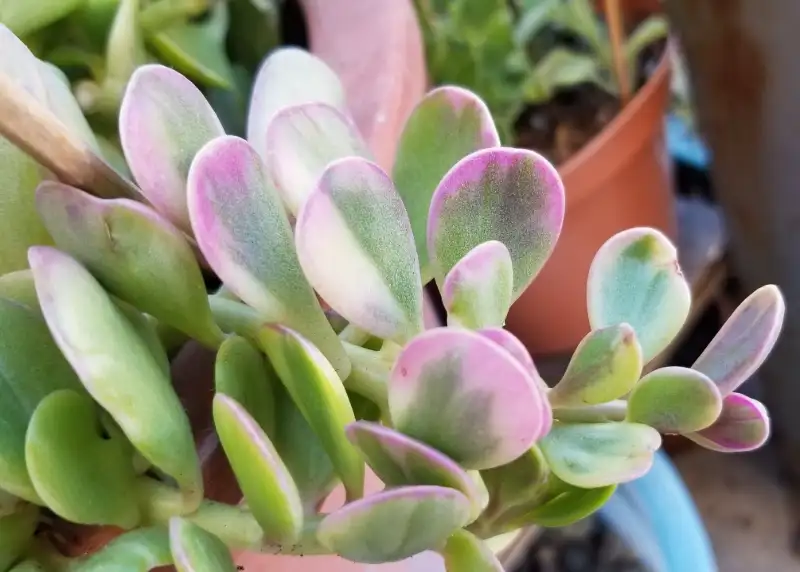
Senecio Jacobsenii ‘Trailing Jades’ are STUNNING PURPLE SUCCULENTS. They have JADE GREEN FOLIAGE and DARK PURPLE EDGES, giving them a lovely PURPLE HUE.
These TRAILING BABIES ensure that they provide AMPLE GROUND COVER. They spread easily and make an attractive addition to any OUTDOOR GARDEN. Jacobsenii twist and contort like YOGA.
This plant is LOW-MAINTENANCE, but this doesn’t mean NO MAINTENANCE. Even my cat, who sleeps 23 hrs a day, needs SOME ATTENTION.
So give your plants in WELL-DRAINING soil pH of 6.0 to 7.5 and ample sun exposure.
Hardiness Zones: USDA zones 10 to 11.
Family: Aizoaceae
Light Requirement: Full sun to partial shade.
Mature Size: 4 to 6 in. tall (11 to 15 cm) and 8 in. in spread (20 cm).
Native Area: Parts of Kenya and Tanzania.
19. Sempervivum Heuffelii ‘Hot Lips’

Sempervivum Heuffelii ‘Hot Lips’ is an ATTRACTIVE PURPLE SUCCULENT. This little lady loves it cold (who doesn’t, am I right?) That makes them a great choice for those gardeners living in NORTHERN ZONES.
Its fleshy leaves have DARK PURPLE COLORS and a SHINY TEXTURE. That’s a little like the Vampires from Twilight. [*Wonders WHY the vampires needed to be shiny*]. That gives my Sempervivum Heuffelii an overall stunning appearance with a PURPLE HUE.
Hardiness Zones: USDA zones 4 to 11.
Family: Crassulaceae
Light Requirement: Full sun to partial shade.
Mature Size: 3 to 4 in. tall (8 to 10 cm) and 6 in. in spread (15 cm).
Native Area: Parts of the Carpathians in Europe.
20. Graptopetalum ‘Purple Delight’
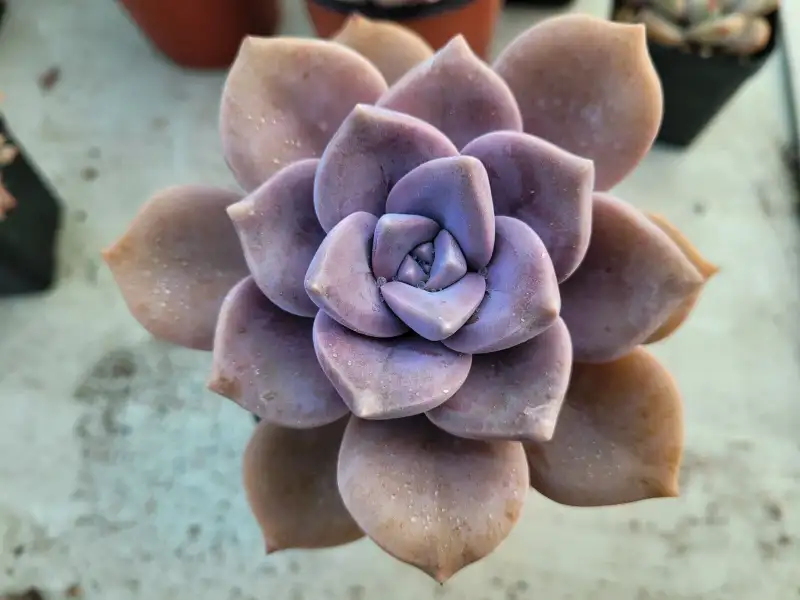
Graptopetalum ‘Purple Delights’ are popular purple succulents to get. They form bi-colored, TIGHT ROSETTES with PINK and DARK PURPLE HUES. Now that switches up things because sometimes green just doesn’t cut it!
It blooms from about spring to EARLY SUMMER season with SMALL PINK FLOWERS. These add a delightful touch of FEMININE FLAIR to an already gorgeous plant.
Its INTENSE PURPLE color can be achieved through ADEQUATE SUN EXPOSURE. Think of it like tanning for your succulents. That makes it one of the best purple succulents out there.
Hardiness Zones: USDA zones 8 to 11.
Family: Crassulaceae
Light Requirement: Full sun to partial shade.
Mature Size: 4 to 5 in. tall (10 to 12.7 cm) and 6 in. in spread (15 cm).
Native Area: Parts of Mexico and Arizona.
21. Aeonium ‘Velour’
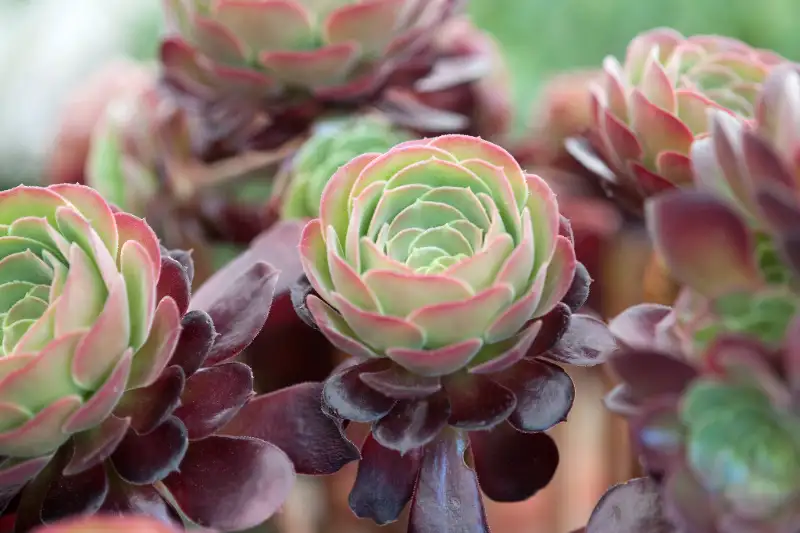
Aeonium ‘Velour’ is a lovely purple succulent. These bad boys are all about showing off their dark purple hue.
Velours form dense rosettes of FLESHY LEAVES covered in fine hairs like PET POODLES. Well, they don’t have that much fur, but they have a VELVETY TEXTURE that is perfect for snuggling up to.
You know what else? They’re TOTAL DIVAS when it comes to fashion, too. Velours bloom in spring with SMALL YELLOW FLOWERS on tall spikes like they OWN THE PLACE. Talk about being born pretty!
Hardiness Zones: USDA zones 9 to 11.
Family: Crassulaceae
Light Requirement: Full sun to partial shade.
Mature Size: 3 to 36 in. tall (7.6 to 91 cm) and 12 in. in spread (30 cm).
Native Area: Parts of North Africa and the Canary Islands.
22. Echeveria Perle Von Nürnberg

Echeveria Perle Von Nürnberg is a POPULAR PURPLE SUCCULENT that gives Tinky Winky a run for his money. It has SOFT, POWDERY leaves in lilac and PASTEL PINK shades that deepen into a DARK PURPLE hue under full sun.
And did we mention they’re TOTAL PARTY ANIMALS too? They bloom during the summer months with PEACH-COLORED FLOWERS on tall stems. That makes them an attractive ground cover plant for any garden space.
I grow these stunning purple succulents in WELL-DRAINING soil with pH 6-7.5. But they are DOWN TO EARTH and can do with ACIDIC, ALKALINE, and NEUTRAL soils. I also water them moderately because they are drought resistant.
Hardiness Zones: USDA zones 9 to 12.
Family: Crassulaceae
Light Requirement: Full to partial sun.
Mature Size: 8 to 10 in. tall (20 to 25 cm) and 8 in. in spread (20cm).
Native Area: Parts of Germany.
23. Sempervivum heuffelii ‘Violet’

Sempervivum heuffelii ‘Violet’ is an INTERESTING purple succulent. It’s like planting a CHAMELEON in your garden.
They have REDDISH-BROWN leaves with a BRIGHT GREEN CENTER. The beautiful rosettes change color during FALL to BLUE-GREEN. And wait for it… drumroll, please…they turn purple with a light outline during WINTER! Who said plants can’t have an OMBRE LOOK?
This Sempervivum heuffelii blooms from LATE SPRING to EARLY SUMMER with BRIGHT YELLOW FLOWERS. Talk about a cherry on top!
Due to its tough nature, this bad boy is COLD HARDY, and DROUGHT RESISTANT. That means taking care of them is basically A BREEZE. So give this Sempervivum heuffelii well-drained soil with pH levels ranging between 5.5 to 7.5.
Hardiness Zones: USDA zones 8 to 11.
Family: Crassulaceae
Light Requirement: Full to partial sun.
Mature Size: 2 to 6 in. tall (5 to 15 cm) and 5 in. in spread (12.7 cm).
Native Area: Parts of Central and Eastern Europe.
24. Sempervivum Dark Beauty

Sempervivum Dark Beauty is characterized by its DARK PURPLE leaves. These stunning purple succulents bloom in SPRING with lovely flowers.
They are so EASY TO GROW that even your lazy neighbor who only mows their lawn once a year can grow them. You know who I’m talking about.
It is very DROUGHT and NEGLECT TOLERANT meaning this baby will thrive even if I forget to water it. That’s just like having a PET ROCK but better because it’s ALIVE.
Hardiness Zones: USDA zones 3 to 8.
Family: Crassulaceae
Light Requirement: Full to partial sun.
Mature Size: 2 to 8 in. tall (5 to 20 cm) and 8 in. in spread (20 cm).
Native Area: Parts of the UK.
25. Sempervivum heuffelii ‘Purple Haze’
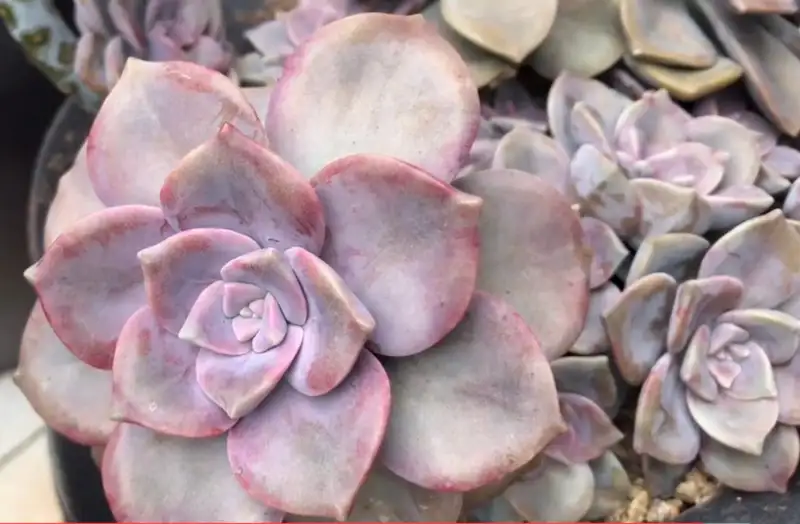
Sempervivum heuffelii ‘purple haze’ is the Jimi Hendrix of succulents. It is famous for its charming LAVENDER to PINK foliage.
This is ANOTHER CHAMELEON in the list as its colors DEEPEN to give it DARK PURPLE LEAVES in the colder months. Throw DARK EYELINER in that garden, and I swear you’ll find some emo plants.
But at least these stunning succulents LIGHTEN in the WARMER MONTHS. It blooms in LATE SPRING and EARLY SUMMER, adding vibrant colors to any garden or landscape.
Don’t worry. You’ll get all this beauty DRAMA FREE. This plant requires WELL-DRAINED SOIL with pH levels between 5.0-7.5. That makes this Sempervivum heuffelii easy to grow for beginners.
Hardiness Zones: USDA zones 8 to 11.
Family: Crassulaceae
Light Requirement: Full to partial sun.
Mature Size: 3 to 6 in. tall (7.6 to 15 cm) and 6 in. in spread (15 cm).
Native Area: Parts of the Carpathians in Europe.
FAQs about Purple Succulents
1. Why do succulents change color?
Succulents change color due to different stress factors. These include light exposure levels, temperature changes, and water stress.
When the plant is under any or many of these stress factors pigments to respond and produce a variety of colors. And that’s why you’ll see your succulents turn red, purple, and brown. In some cases, extreme weather conditions also affect a succulent’s color.
2. What is the difference between a cacti and succulent?
Although all cacti are succulents, not all succulents are cacti. To begin with, succulents have leaves and stem that store water to survive harsh environments. Think deserts. Cacti have a distinctive appearance.
They have spines and flowers growing all over the plant’s body at the apex. Most other types of succulents do not feature spikes or sharp edges like cactus plants. So, if it is prickly, it is a cactus.
3. How many days can succulents survive without water?
The time in which succulents can survive without water depends on several factors. These include the species, pot size, humidity level, and temperature. Most healthy and well-maintained succulents will live for about 2-3 weeks without water.
That’s more than the 2 minutes you can stay without air. However, watch your plants closely to prevent dehydration issues.
4. Why is Echeveria succulent turning into a black-purple color?
It looks like your Echeveria love going through a goth phase. But in all seriousness, several stressor factors can turn your plants black-purple color.
Common reasons include overwatering or lack of sunlight. Check the soil and ensure it’s not too moist, and move the plant to an area with more direct sunlight if possible.
5. What are the best growing conditions for a purple succulent?
Make sure it’s in well-draining soil and gets plenty of sunlight. Don’t overwater them – let the soil dry out between waterings. They are succulents and not goldfish, after all.
And REMEMBER, just like humans, plants come in all different shapes and sizes. So research your specific type of succulent to get a less one size fits all care approach!
What’s Next
You learned about purple succulents. We marinated you with the reasons to get these succulents.
Then we reviewed 25 types of these beauties and what makes them unique and happy. So next time you see one of these guys at your local nursery, don’t hesitate to get one. They’ll make your life “succ” a bit less!
Do you want to add some purple succulents to your garden? AsterGardening is here to help you scratch that itch! We have many helpful TIPS to bring your succulent game to the next level.
Or, Do you want to tackle other gardening problems? Worry not cause our experts have you covered. Let’s step up your gardening. Check us out today!
